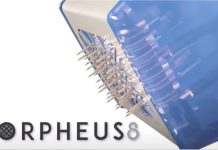
The CellFX® System from Pulse Biosciences is now approved via a Medical Device License from Health Canada for use in dermatological procedures requiring ablation and resurfacing of the skin for the reduction, removal, and/or clearance of cellular-based benign lesions. Pulse Biosciences will now expand its controlled commercial launch of the CellFX System to select medical practices in Canada for the treatment of general dermatologic conditions, including sebaceous hyperplasia, seborrheic keratosis and cutaneous non-genital warts.
“I am thrilled to be the first dermatologist in Canada to provide the clinical advantages of the CellFX System using NPS technology,” says dermatologist Sheetal Sapra, MD of Toronto, who is expected to begin participation in the CellFX System Controlled Launch program this month. “I’m constantly seeking innovative ways to help my patients and I see an unmet need that the CellFX procedure can address in clearing challenging skin lesions like sebaceous hyperplasia, common warts and seborrheic keratosis.” Dr. Sapra is co-founder and director of the Institute of Cosmetic and Laser Surgery and Centre for Clinical Trials.
“Health Canada approval marks an important corporate milestone in our regulatory strategy and enables the planned expansion of our CellFX System Controlled Launch program in Canada this quarter. This third regulatory approval, following FDA clearance and CE mark approval earlier this year, further validates our NPS technology and we are excited to bring our novel CellFX procedure to patients in Canada,” says Darrin Uecker, President and Chief Executive Officer of Pulse Biosciences. “We look forward to initiating our controlled launch program with leading aesthetic dermatologists in Canada, expanding to an estimated 80 practices participating across the US, EU and Canada.”
The CellFX System is a multi-application platform that harnesses the Company’s proprietary NPS technology delivering nano-second pulses of electrical energy to non-thermally clear cells while sparing adjacent noncellular tissue. The distinct advantages of the NPS mechanism have the potential to improve clinical and aesthetic outcomes by clearing benign lesions where important treatment gaps exist.






